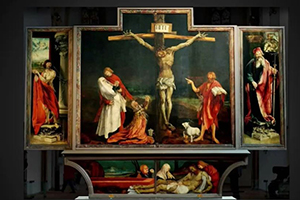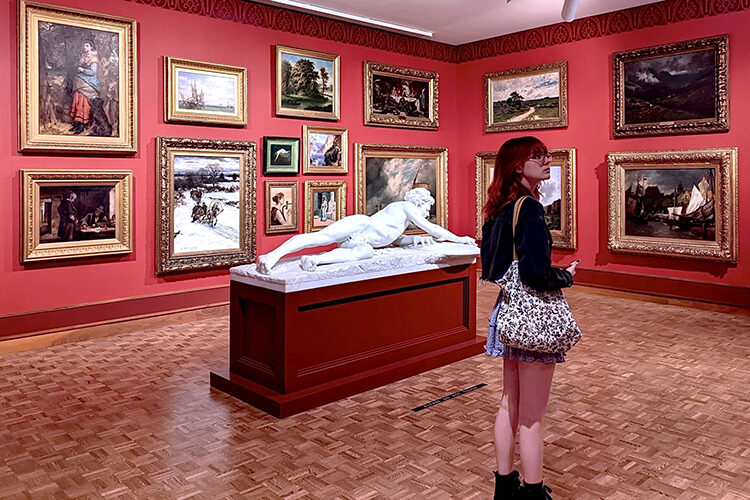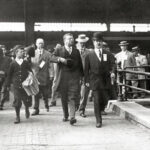The Isenheim Altarpiece by Matthias Grünewald, created between 1512 and 1516, is a triptych painting depicting the suffering and crucifixion of Christ, flanked by saints Sebastian and Anthony, in its closed position. When opened, the painting shows far more joyful images of Christ’s birth, resurrection and ascension to the heavens. It is considered Grunewald’s masterpiece and is an important representative of religious and Renaissance art – and it could also be considered one of the first pieces used for art therapy.
“(It was shown) to patients who were being treated in a monastery by monks,” explained Maggie Kennedy. “The Antonine monks, I argue, are some of the first documented therapists in history. The altarpiece was available for their patients to look at, and represented hope. The Antonine monks used the symbolism of the work to reassure their patients that things were going to be okay.”
It may be one of the first documented uses of using art to treat psychological problems, but Kennedy says art throughout history has been a window into the mind and its psychology. It’s been the focus of her most recent research as a student working toward double majors in art history and psychology.
“I think psychology and art history are both really interdisciplinary by nature,” she said. “They are so vast that it’s very easy to blend them with a lot of other things.”
Unexpected overlap
Kennedy grew up primarily in Germantown. When it came time for college, she wanted a big school, plenty of choices for classes and research opportunities. She found all three at UW-Milwaukee, which is an R1-ranked research institution.
Kennedy initially majored in psychology. She had taken an AP psychology course in high school and fell in love with the field after she and her schoolmates got to hold a human brain and spinal cord in class.
She was making strides in her psychology major at UWM when a scheduling error prompted her to take an art history course instead of a course for her major. “After four weeks, I discovered I really had a passion for art history,” Kennedy said.
What she didn’t expect was how much her two majors seemed to overlap. Kennedy recalled analyzing the painter Francisco de Goya for a class and how his personal struggles with illness, blindness and hearing loss led to some of his most striking artworks. Art history, she thought, represented a new way to analyze the mind.
How art reflects the human condition
So when one of her English classes asked students to complete a research project on a topic of their choosing, Kennedy already knew what she wanted to explore. The result was a 20-minute presentation on how art through time has reflected the human condition in all of its forms.

She opened with two marble sculptures from ancient Greece, each showcasing the beginnings of how emotion is depicted in art. From there, Kennedy delved into post-Enlightenment romanticism, examining the conditions of an insane asylum in de Goya’s “Madhouse” (1812-1819) and the faces of those with psychological disorders in Theodore Gericault’s “Monomanies” series (1821-1824), among others. She also explored the horrors of battle with “War Pieta” by Max Ginsburg (2007) and ended with the Isenheim Altarpiece.
“My goal was to show the human experience as a whole,” Kennedy said of her research. “How do artistic depictions of the human experience and human emotion make us feel and think? What are the tie-ins to the cultures or time periods that they’re from? What are the social norms and taboos of the time, and in turn, how do they shape experience and emotion?”
For instance, she said, the Isenheim Altarpiece is an important artwork not only for its religious significance, but also for its scientific accuracy. Originally painted for the Isenheim Monastery, the piece depicts many of its subjects with haloes of light around their heads. Kennedy said those orbs are meant to represent patients’ hallucinogenic symptoms. These patients, cared for by the Antonine monks at the monastery, suffered from St. Anthony’s Fire, a disease caused by ergot poisoning that led to hallucinations, gangrene and a burning sensation in the extremities.
Scientific and philosophical psychology
According to Kennedy, the Altarpiece shows that “people are starting to understand that this (disease) isn’t just ‘crazy people seeing stuff.’ Even though it’s a very religious piece … they understand that St. Anthony’s fire is a physical illness (versus a religious punishment),” Kennedy said. “This insight is important for acknowledging the history of both scientific and philosophical psychology.”
Understanding how art and psychology relate is important, she added. Studying psychology through an art lens helps scholars better understand the human mind and how people viewed emotion, trauma, disease, and more throughout history. Kennedy stresses that while she’s not yet an expert in either psychology or art history, her studies have helped her uncover one more way to examine how humanity relates to one another.
Kennedy plans to graduate one year early in 2024 and is exploring options for graduate school. Until then, she’ll be studying human psychology, one painting at a time.







